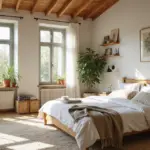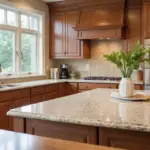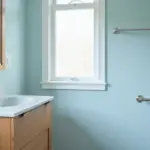Transforming a functional bathroom into your personal sanctuary doesn’t have to be overwhelming. I’ve spent years helping clients blend zen principles with modern functionality, and I’ve discovered that the most successful bathroom renovations balance mindful planning with thoughtful design choices.
Ready to create a space that calms your mind while meeting your practical needs? Let’s dive into these 21 bathroom renovation tips that will guide you from planning to those final perfect touches.
1. Set a Smart Budget: Know Your Limits Before You Start
Your budget isn’t just a number—it’s the foundation that shapes every decision in your renovation journey. Without clear financial boundaries, costs spiral quickly, potentially leaving you with half-finished projects and serious regrets. I’ve seen too many clients rush into demolition without understanding the full financial picture.

Creating a detailed budget requires honest assessment of several factors: the size of your bathroom, scope of work, material quality, and labor costs. Always include a 15-20% contingency fund—this isn’t being pessimistic, it’s being realistic. Even in the most carefully planned renovations, surprises hide behind walls and under floors.
“The difference between a stressful renovation and a successful one often comes down to how well you’ve prepared your budget.”
Here’s the catch—your budget will determine which of the following bathroom renovation tips you can implement immediately and which might need to wait for phase two.
2. Needs vs. Wants: Distinguish for a Budget-Friendly Reno
When I sit down with clients for the first time, I always ask them to create two lists: must-haves and nice-to-haves. This simple exercise cuts through the excitement of Pinterest boards and brings clarity to what truly matters. Your needs list should include anything that affects basic functionality and safety—fixing leaky plumbing, addressing mold issues, ensuring proper ventilation, and updating unsafe electrical systems.

Your wants list might include that gorgeous freestanding tub, heated floors, or custom cabinetry. These elements enhance enjoyment but aren’t essential for the bathroom to function. The beauty of this approach? You can tackle needs immediately while phasing in wants as your budget allows.
- Needs checklist:
- Functional plumbing without leaks
- Safe electrical systems
- Proper ventilation
- Adequate lighting
- Waterproof surfaces
What complicates this is our tendency to blur the line between needs and wants. That rainfall showerhead might feel essential, but honest assessment will guide your spending toward what truly matters first.
3. Layout is Key: Master the Flow for a Functional Bathroom
The layout is where function meets form in bathroom design. A well-planned layout creates a sense of spaciousness even in compact areas—something I specialize in with my Japanese-inspired approach. Poor layouts lead to daily frustrations: bumping into fixtures, awkward reaches for essentials, and a general feeling of confinement in what should be your personal retreat.

When planning your layout, work with the existing architecture when possible. Consider door swing direction (an inward-swinging door can block access), traffic flow between fixtures, and comfortable clearances. In my practice, I find that minimizing plumbing relocation saves substantial costs, but sometimes moving fixtures is necessary for true functionality.
Picture it this way: your bathroom should feel like a choreographed dance where every movement flows naturally from one area to the next. This mindful approach to space planning transforms even the smallest bathrooms into functional sanctuaries.
4. Plumbing Power: Keep Existing Lines or Relocate Wisely?
The hidden network of pipes behind your walls represents one of the biggest potential costs in your renovation. The decision to keep existing plumbing or relocate it isn’t just about aesthetics—it’s a financial watershed moment. Moving a toilet across the room might create your dream layout, but it could add thousands to your budget.

Before committing to plumbing relocation, get multiple quotes and understand exactly what’s involved. Sometimes, the solution lies in compromise—perhaps a slightly smaller vanity that works with existing pipes, or a shower configuration that minimizes new plumbing runs. In my design practice, I often find creative solutions that honor both the vision and the budget.
- Consider plumbing relocation when:
- Existing pipes are outdated or damaged
- Current layout significantly compromises functionality
- You’re converting a tub to a shower (or vice versa)
- Your dream layout absolutely requires it
The tricky part is balancing what you want with what makes practical sense. Sometimes the wisest choice is working with what you have, while other times, investment in new plumbing pays dividends in daily enjoyment.
5. Shop Around for Quotes: Secure the Best Deals from Contractors
Finding the right contractor is like finding the perfect meditation teacher—you need someone who understands your vision while bringing technical expertise to realize it. Never settle for the first quote you receive. Multiple estimates give you leverage, market insight, and protection against both overcharging and corner-cutting.

When comparing quotes, look beyond the bottom line. A comprehensive quote breaks down costs for materials, labor, permits, and other expenses. It specifies brands and quality levels, includes a timeline, and clearly states what’s excluded. I always advise my clients to check references and portfolio work—past projects speak volumes about a contractor’s reliability and craftsmanship.
The heart of the matter is finding a partner who respects both your vision and your budget. The right contractor becomes a collaborator in creating your sanctuary, not just someone executing tasks.
6. Define Your Style: From Spa-Like Serenity to Modern Chic
Before selecting a single tile or fixture, take time to define your bathroom’s aesthetic direction. This isn’t just about pretty pictures—it’s about creating a cohesive environment that resonates with you on a deeper level. Without a clear style vision, you risk making disconnected choices that result in a bathroom that feels unfocused and unsatisfying.

In my design practice, I often blend contemporary Japanese aesthetics with modern functionality. This might mean clean lines and natural materials paired with smart storage solutions and integrated technology. Your style might lean toward spa-like tranquility with soft neutrals and natural textures, or perhaps bold modern chic with geometric patterns and statement fixtures. Whatever you choose, let it guide every selection from major elements to small details.
- Popular bathroom styles to consider:
- Zen Minimalist: Clean lines, natural materials, uncluttered spaces
- Modern Industrial: Raw textures, metal finishes, utilitarian elegance
- Classic Timeless: Subway tiles, marble, traditional fixtures
- Coastal Retreat: Blues and whites, beachy textures, light woods
- Luxury Spa: Natural stone, rainfall showers, freestanding tubs
Let that sink in for a moment—your style choice becomes the foundation for every decision that follows, from lighting design to hardware selection.
7. Light it Right: Layer Lighting for Ambiance and Function
Lighting transforms the bathroom experience, yet it’s often reduced to a single overhead fixture that casts unflattering shadows. My approach to bathroom lighting draws from traditional Japanese design principles where light is treated as a material in itself—something to be shaped and layered for both function and mood.

The key is creating three distinct lighting layers: ambient, task, and accent. Ambient lighting provides overall illumination through ceiling fixtures or wall sconces. Task lighting focuses on specific activities—vanity lights for grooming, reading lights near the tub. Accent lighting adds drama and highlights architectural features through strip lighting or spotlights. Each layer should be independently controlled, ideally with dimmers for maximum flexibility.
The breakthrough came when I started designing bathrooms with lighting that adapts to different times of day and activities. Morning preparation requires bright, energizing light, while evening relaxation calls for soft, calming illumination. This mindful approach to lighting creates a bathroom that truly responds to your needs.
8. Tile Tales: Choose Durable and Stylish Surfaces Wisely
Tiles are the skin of your bathroom—they define its character while providing essential protection against moisture. The tile choices you make impact both aesthetics and long-term durability, making this one of the most crucial bathroom renovation tips to consider carefully.

For flooring, prioritize slip resistance and durability with porcelain tiles rated PEI 3 or higher. Walls offer more flexibility—you might choose large-format tiles for minimal grout lines (and easier cleaning) or intricate mosaics for visual interest. In my designs, I often combine different tile types: perhaps larger, simpler tiles for most surfaces with decorative accents in key areas like the shower niche or backsplash.
- Tile selection tips:
- Test samples in your actual bathroom lighting
- Consider maintenance requirements—some tiles need regular sealing
- Choose appropriate tiles for each location (floor vs. wall vs. shower)
- Select grout colors carefully—they dramatically affect the final look
What really matters here is finding the balance between beauty and practicality. The most stunning tile becomes a source of frustration if it’s constantly showing water spots or requires excessive maintenance.
9. Fixture Focus: Select Statement Pieces that Shine
Think of fixtures as the jewelry of your bathroom—they can elevate the entire space with their presence. A striking vanity, sculptural faucet, or distinctive light fixture becomes a focal point that defines the room’s character. In my design practice, I often recommend investing in one or two high-impact pieces rather than spreading the budget thinly across everything.

Statement fixtures don’t have to be the most expensive elements—they simply need to capture attention and express your style. A vintage-inspired brass faucet might become the star against simple white tiles. A uniquely shaped mirror could transform a basic wall into a design feature. Even something as simple as matte black hardware can create dramatic contrast in an otherwise neutral space.
The game-changer happened when I realized that statement pieces should be both beautiful and functional. That stunning faucet needs to deliver water efficiently, that gorgeous vanity must provide adequate storage, and that eye-catching light fixture should illuminate properly. When style meets substance, you create a bathroom that truly works.
10. Storage Savvy: Maximize Space with Clever Solutions
Nothing undermines the serenity of a beautiful bathroom faster than clutter. In Japanese design philosophy, clear space creates mental calm—a principle I apply to every bathroom renovation. Smart storage solutions maintain this tranquility while keeping essentials accessible.

Look beyond standard vanities to maximize every inch. Recessed medicine cabinets utilize wall depth without protruding into the room. Floating shelves add storage without visual heaviness. Niches built into shower walls provide convenient spots for toiletries without cluttering the perimeter. For smaller bathrooms, consider vertical storage that draws the eye upward and makes the space feel larger.
- Innovative bathroom storage ideas:
- Toe-kick drawers beneath vanities
- Over-toilet cabinets or shelving
- Built-in shower niches
- Magnetic strips for metal grooming tools
- Hidden storage behind mirrors
The missing piece is often thinking three-dimensionally about your space. Walls, corners, and even the area behind doors offer storage potential that most renovations overlook.
11. Personalize Your Paradise: Inject Your Style into the Details
A truly successful bathroom renovation reflects your personality while maintaining design coherence. Without personal touches, even the most expensive bathroom can feel like a hotel suite—pleasant but impersonal. The challenge is adding character without creating visual chaos.

Personalization comes through thoughtful details: perhaps artwork that inspires you, textiles in colors you love, or accessories that tell your story. In my design practice, I encourage clients to incorporate elements that hold meaning—perhaps stones collected from a special beach trip displayed in a glass vessel, or a plant variety that reminds you of a favorite place. These touches create connection and make the space uniquely yours.
Things took an interesting turn when I started helping clients identify their “daily rituals” and designing spaces to enhance these moments. For some, it’s a morning skincare routine that requires specific organization. For others, it’s an evening bath that needs ambiance. Personalizing around these rituals creates a bathroom that truly supports your lifestyle.
12. Waterproof Wonders: Opt for Moisture-Resistant Materials
Bathrooms exist in a constant battle with moisture, making material selection critically important. I’ve seen beautiful renovations deteriorate within years because this fundamental principle was overlooked. Every surface in your bathroom should be selected with moisture resistance in mind.

For walls in wet areas, cement board provides the ideal substrate for tile. For flooring, porcelain tile offers superior water resistance compared to ceramic. When incorporating wood elements, choose water-resistant varieties like teak or cedar, or opt for high-quality waterproof alternatives that mimic wood’s warmth. Even paint selection matters—choose formulations specifically designed for high-moisture environments.
“The most beautiful bathroom will quickly lose its charm if moisture issues lead to mold, warping, or deterioration. Prevention through proper materials is always less expensive than remediation.”
The heart of the matter is creating a bathroom that maintains its beauty for years, not just months. Moisture-resistant materials might cost more initially but pay dividends through longevity and reduced maintenance.
13. Ventilation Victory: Banish Moisture and Prevent Mold
Even with perfect waterproofing, bathrooms need proper air circulation to prevent humidity buildup. This might be the least glamorous of my bathroom renovation tips, but it’s perhaps the most important for long-term satisfaction. Inadequate ventilation leads to mold, mildew, peeling paint, and damaged materials—problems that no beautiful fixture can compensate for.

When selecting a ventilation fan, size matters. Calculate the appropriate CFM (cubic feet per minute) based on your bathroom’s square footage—generally 1 CFM per square foot, with additional capacity for separate toilet or shower areas. Consider noise levels too; fans rated 1.0 sone or less operate quietly enough not to disrupt your peaceful environment. Modern fans offer helpful features like humidity sensors, timers, and even Bluetooth speakers for a truly integrated experience.
The breakthrough came when I started treating ventilation as part of the design rather than an afterthought. In some renovations, I’ve incorporated multiple fans strategically placed near moisture sources, or designed custom vent covers that complement the overall aesthetic while performing their essential function.
14. Upgrade Essentials: Don’t Neglect Plumbing and Electrical
Behind your beautiful tiles and fixtures lies the infrastructure that makes everything work—plumbing and electrical systems that deserve careful attention during renovation. Skimping on these unseen elements often leads to frustrating problems down the road, from insufficient water pressure to inadequate lighting circuits.

Use your renovation as an opportunity to upgrade aging pipes, especially if you have galvanized steel or lead plumbing. Consider installing dedicated electrical circuits for high-draw appliances like hair dryers or heated floors. Ensure GFCIs (ground fault circuit interrupters) protect all outlets. These investments might not be visible in your finished bathroom, but they significantly impact its functionality and safety.
- Key infrastructure upgrades to consider:
- Replacing outdated pipes with copper or PEX
- Installing individual shut-off valves for each fixture
- Upgrading electrical panel capacity if needed
- Adding dedicated circuits for specialty features
- Waterproofing electrical components properly
The stumbling block is that these improvements often get cut when budgets tighten, but they’re the foundation of a truly successful renovation. Prioritize this infrastructure before splurging on visible elements.
15. Go Green, Save Green: Embrace Energy-Efficient Fixtures
Sustainability and savings come together beautifully in modern bathroom design. Energy-efficient fixtures not only reduce your environmental footprint but also lower monthly utility bills. This mindful approach aligns perfectly with the Japanese concept of mottainai—the sense that waste is deeply regrettable.

Look for WaterSense-labeled fixtures, which use at least 20% less water while maintaining performance. Low-flow toilets, showerheads, and faucets make a significant difference without compromising your experience. LED lighting uses a fraction of the energy of traditional bulbs while lasting years longer. Consider a tankless water heater for on-demand hot water without standby energy loss.
- Water and energy saving potential:
- Low-flow toilets save up to 13,000 gallons annually
- Efficient showerheads reduce water usage by thousands of gallons yearly
- LED lighting uses 75% less energy than incandescent
- Motion-sensor faucets prevent unnecessary water flow
What really matters here is that efficiency doesn’t mean sacrifice. Today’s eco-friendly fixtures perform beautifully while conserving resources—a perfect harmony of function, sustainability, and design.
16. Future-Proof Your Space: Consider Accessibility and Aging in Place
Designing with foresight means creating a bathroom that serves you well today and adapts to changing needs tomorrow. This approach, deeply rooted in thoughtful planning, ensures your renovation remains relevant and functional for years to come. I often remind clients that accessibility features benefit everyone, not just those with mobility challenges.

Start with fundamental elements like wider doorways (32″ minimum) and curbless showers that eliminate tripping hazards. Consider comfort-height toilets and strategically placed blocking in walls for future grab bar installation. Lever-style handles on faucets and doors are easier for everyone to operate. These features can be incorporated elegantly without creating an institutional feel—in fact, many align perfectly with clean, modern design aesthetics.
The missing piece is often thinking beyond current needs to potential future scenarios. The shower bench that seems unnecessary today might become essential after an injury or as you age. The extra clearance around fixtures that feels spacious now becomes crucial if mobility changes. These forward-thinking choices protect your investment while creating a bathroom that adapts to life’s changes.
17. DIY or Hire? Know Your Limits for a Stress-Free Reno
The question of whether to DIY or hire professionals is central to any bathroom renovation. While the DIY approach promises cost savings and personal satisfaction, it also demands skills, time, and patience that not everyone possesses. In my experience, the most successful renovations often involve a thoughtful blend of professional work and personal contributions.

Be honest about your capabilities. Tasks like demolition, painting, and some decorative work are often DIY-friendly. Specialized work—plumbing, electrical, waterproofing, and tile installation—typically benefits from professional expertise. Consider the consequences of mistakes: a painting error is easily fixed, while improper waterproofing can cause thousands in damage. Also factor in your time—a professional might complete in days what would take you weeks of evenings and weekends.
“The wisest DIYers know when to pick up the tools and when to pick up the phone for professional help.”
The game-changer happened when I started recommending a hybrid approach to clients—professionals handling critical infrastructure while homeowners tackle suitable projects. This collaboration often yields the best of both worlds: professional quality where it matters most and personal satisfaction from direct contribution.
18. Step-by-Step Success: Plan Your Renovation Timeline
A bathroom renovation unfolds in distinct phases, each building upon the last. Without a clear timeline, these phases can overlap chaotically or stretch indefinitely. I’ve found that understanding this sequence helps manage expectations and reduces stress during what can be a disruptive process.

Start with planning and design (1-4 weeks), where you’ll define scope, finalize plans, select materials, and secure permits. Demolition follows (1-3 days), removing existing fixtures and surfaces. The rough-in phase (3-7 days) addresses plumbing, electrical, and HVAC work behind walls. Wall and floor preparation (2-5 days) creates the foundation for finishes. Tile installation (3-10 days) is followed by fixture installation (1-3 days), then finishing touches like paint, accessories, and cleanup (2-4 days).
- Timeline planning tips:
- Order materials well before demolition begins
- Schedule contractors in advance, confirming dates as you approach each phase
- Build in buffer days between phases for unexpected issues
- Consider how you’ll manage without the bathroom during renovation
- Create decision deadlines for selections to prevent delays
The crucial element is understanding that bathroom renovation is a process, not an event. Respecting this process and allowing appropriate time for each phase leads to better results and less stress.
19. Detail is Divine: Don’t Overlook the Finishing Touches
The difference between a good bathroom and an exceptional one often comes down to meticulous attention to finishing details. These seemingly minor elements—grout color, caulk application, trim work—create a polished, cohesive look that elevates the entire space. In Japanese design philosophy, these details aren’t afterthoughts but essential components of the overall harmony.

Pay attention to transitions between materials, ensuring clean lines and proper sealing. Choose grout color thoughtfully—it can dramatically alter the appearance of tile, either highlighting or minimizing the grid pattern. Coordinate all metal finishes for a unified look. Install switch plates and outlet covers that complement your design rather than distract from it. These small touches require minimal additional investment but yield significant aesthetic returns.
The ripple effects are enormous when these details are handled with care. A bathroom where every element has been thoughtfully considered feels intentional and complete, creating a sense of quality that transcends the sum of its parts.
20. Accessorize to Impress: Add Mirrors, Art, and Flair
Accessories are the final layer that brings personality and life to your bathroom. They’re also the elements you can most easily change over time, allowing your space to evolve with your tastes. I approach bathroom accessories as I would in traditional Japanese spaces—with intention and restraint, ensuring each piece serves both functional and aesthetic purposes.

Mirrors deserve special attention as they impact both functionality and perceived space. Consider size, shape, and frame style carefully—a statement mirror can become a focal point, while multiple mirrors can bounce light and create the illusion of expanded space. Art brings color and personality but choose pieces that can withstand humidity or protect them appropriately. Don’t forget textiles—quality towels, bathmats, and shower curtains add softness and color to what can otherwise be a hard-surfaced environment.
- Impactful bathroom accessories:
- Sculptural tissue holders or soap dispensers
- Plants that thrive in humidity (ferns, orchids, pothos)
- Decorative trays for corralling countertop items
- Unique hardware for cabinets and drawers
- Textured or patterned towels for visual interest
My discovery began when I started treating bathroom accessories as curated collections rather than random additions. This mindful approach ensures each piece contributes to the overall experience while avoiding cluttered chaos.
21. Don’t Forget the Small Stuff: Hardware and Accessories Matter
The smallest details often make the most significant impact in bathroom design. Hardware—those knobs, pulls, towel bars, and hooks—might seem inconsequential, but they’re like punctuation marks in a sentence, giving emphasis and clarity to your design statement. These elements should be chosen with the same care as your major fixtures.

Consistency in finishes creates a cohesive look—mixing metals can work when done intentionally, but random variation often feels haphazard. Consider the practical aspects too: towel bars should accommodate your largest towels, toilet paper holders should be conveniently placed, and hooks should be sturdy enough for wet robes. These functional considerations ensure your beautiful bathroom works as well as it looks.
“In the bathroom, as in life, it’s often the smallest details that leave the strongest impression.”
You could compare it to the concept of wabi-sabi—finding beauty in imperfection and authenticity. Well-chosen hardware embraces this philosophy, adding character and functionality in perfect harmony with your overall design vision.
Conclusion: Your Dream Oasis Awaits
Creating your dream bathroom is a journey of thoughtful choices, from the big decisions like layout and fixtures to the small details like hardware and accessories. These 21 bathroom renovation tips provide a roadmap, but the heart of a successful renovation lies in balancing practical needs with personal expression.
Remember that your bathroom should be more than just functional—it should be a sanctuary that supports your daily rituals and provides respite from the digital noise of modern life. By approaching your renovation with mindfulness and intention, you’ll create a space that nurtures wellbeing and brings daily moments of joy.
Whether you’re planning a simple refresh or a complete transformation, let these bathroom renovation tips guide you toward creating a space that’s not just Instagram-worthy, but truly life-enhancing. Your perfect bathroom oasis isn’t just a dream—it’s an achievable reality waiting to be realized.






